International affairs reporting during crises requires a strategic blend of real-time techniques and local insights to deliver accurate and timely information. By adhering to best practices that emphasize accuracy, ethical considerations, and context, journalists can effectively inform the public about complex situations as they develop. Utilizing various tools for data gathering and analysis further enhances their ability to provide reliable coverage in fast-paced environments.

How do international affairs reporters cover crises in Europe?
International affairs reporters cover crises in Europe by employing a mix of real-time reporting techniques and leveraging local sources to provide accurate and timely information. This approach ensures that audiences receive comprehensive insights into complex situations as they unfold.
Real-time reporting techniques
Real-time reporting techniques involve using digital platforms and social media to disseminate information quickly. Journalists often rely on live updates, video feeds, and instant messaging to share developments as they happen, which is crucial during fast-moving crises.
Tools like Twitter, Facebook, and dedicated news apps allow reporters to reach audiences instantly, but they must verify information before publication to avoid spreading misinformation. Establishing a reliable network of contacts can enhance the speed and accuracy of reporting.
Use of local sources
Utilizing local sources is essential for gaining context and depth in crisis coverage. Local journalists, community leaders, and residents can provide firsthand accounts and insights that international reporters may not access otherwise.
Building relationships with these sources can lead to more nuanced stories. Reporters should approach local contacts with respect and transparency, ensuring that their contributions are acknowledged and that ethical standards are maintained.
Case study: Ukraine conflict
The Ukraine conflict serves as a prominent example of crisis coverage in Europe, showcasing the challenges and strategies employed by international reporters. Journalists have used real-time updates and local sources extensively to convey the rapidly changing situation on the ground.
For instance, during the initial stages of the conflict, reporters relied heavily on social media for immediate updates and local insights, which helped paint a clearer picture of the humanitarian impact. They also faced challenges such as restricted access to certain areas and the need for safety precautions, which required careful planning and coordination.
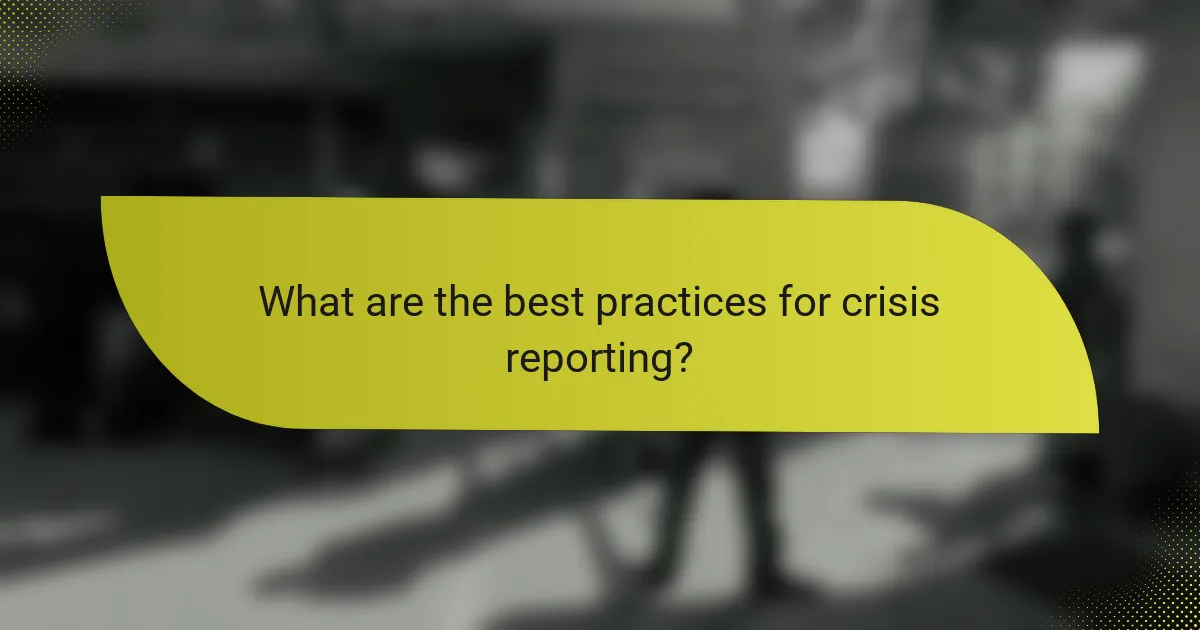
What are the best practices for crisis reporting?
Best practices for crisis reporting focus on accuracy, timeliness, and ethical considerations. Journalists must prioritize fact-checking, maintain integrity, and provide context to ensure reliable information reaches the public swiftly.
Fact-checking protocols
Fact-checking is crucial in crisis reporting to prevent the spread of misinformation. Journalists should verify information through multiple credible sources before publication. This can include official statements, eyewitness accounts, and reputable news outlets.
Establishing a clear protocol for fact-checking can help streamline the process. For instance, journalists might create a checklist that includes confirming the source’s credibility, cross-referencing facts, and assessing the reliability of the information provided.
In high-pressure situations, it’s easy to rush. However, taking the time to fact-check can significantly enhance the credibility of the report and protect against potential backlash or legal issues.
Maintaining journalistic integrity
Maintaining journalistic integrity during a crisis is essential for building trust with the audience. Reporters should avoid sensationalism and strive for balanced coverage that presents multiple perspectives. This approach fosters a more informed public.
Transparency is another key aspect of integrity. Journalists should disclose any conflicts of interest and clarify the sources of their information. For example, if a source has a vested interest in the story, this should be made clear to the audience.
Additionally, adhering to established ethical guidelines, such as those from the Society of Professional Journalists, can help journalists navigate complex situations while upholding their responsibility to report truthfully and fairly.

What tools do reporters use for crisis coverage?
Reporters utilize a variety of tools for crisis coverage to gather, analyze, and disseminate information quickly and accurately. These tools enhance their ability to monitor events in real-time and present data in an understandable format.
Social media monitoring tools
Social media monitoring tools allow reporters to track real-time conversations and trends related to a crisis. Platforms like Hootsuite, TweetDeck, and Brandwatch enable journalists to filter content by keywords, hashtags, and locations, providing insights into public sentiment and emerging narratives.
When using these tools, it’s essential to verify information before reporting. Misinformation can spread rapidly on social media, so cross-referencing with credible news sources is crucial. Additionally, setting up alerts for specific terms can help reporters stay updated on breaking news.
Data visualization software
Data visualization software helps reporters present complex information in a clear and engaging manner. Tools such as Tableau, Google Data Studio, and Infogram allow journalists to create charts, maps, and infographics that make data more accessible to the audience.
Effective data visualization can highlight key trends and statistics that are vital during a crisis. Reporters should focus on simplicity and clarity when designing visuals, ensuring that they convey the intended message without overwhelming the viewer. Utilizing templates can save time and maintain consistency across reports.
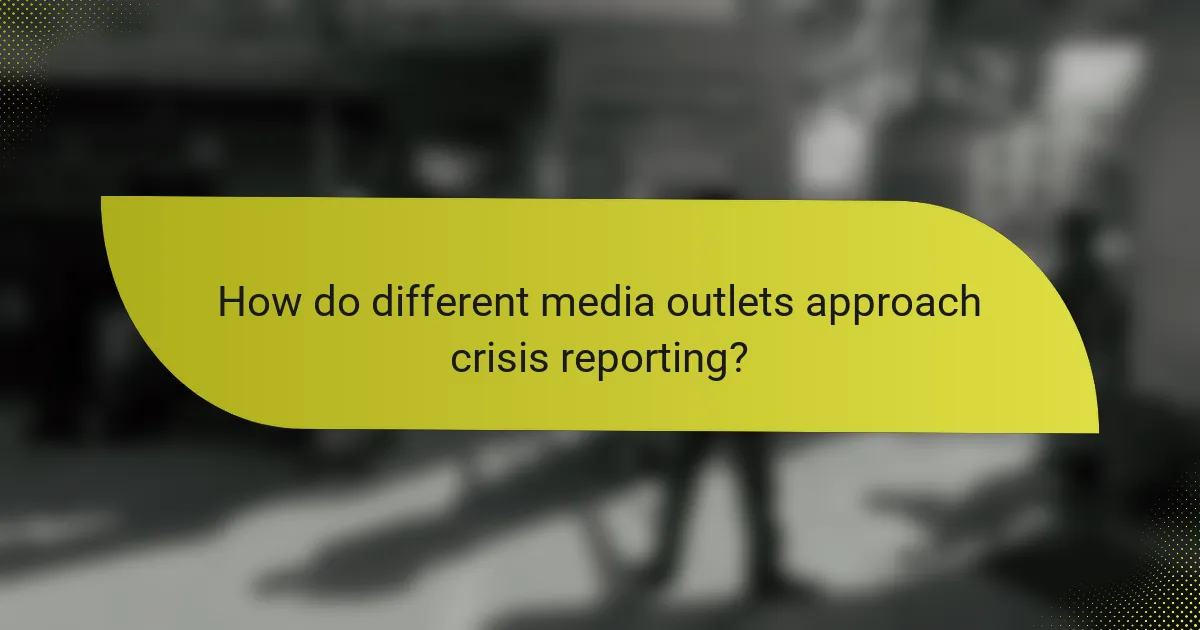
How do different media outlets approach crisis reporting?
Different media outlets adopt varied strategies for crisis reporting, influenced by their editorial policies, audience expectations, and regional contexts. Outlets like CNN and BBC prioritize timely updates and in-depth analysis, but their approaches to framing stories and engaging audiences can differ significantly.
Comparative analysis of CNN and BBC
CNN typically emphasizes rapid updates and live coverage during crises, often featuring breaking news alerts and on-the-ground reporting. This approach aims to capture the immediacy of events, appealing to viewers seeking real-time information.
In contrast, the BBC focuses on comprehensive context and analysis, often providing background information and expert opinions alongside breaking news. This method caters to an audience that values depth and understanding, especially in complex international situations.
Impact of audience demographics
Audience demographics significantly influence how media outlets report crises. For instance, CNN’s audience tends to be younger and more engaged with social media, prompting the outlet to adopt a fast-paced reporting style that resonates with this demographic.
Conversely, the BBC’s audience often includes older viewers who prefer detailed narratives and thorough analysis. This demographic inclination leads the BBC to prioritize context and reliability, ensuring that their reporting meets the expectations of a more traditional audience.
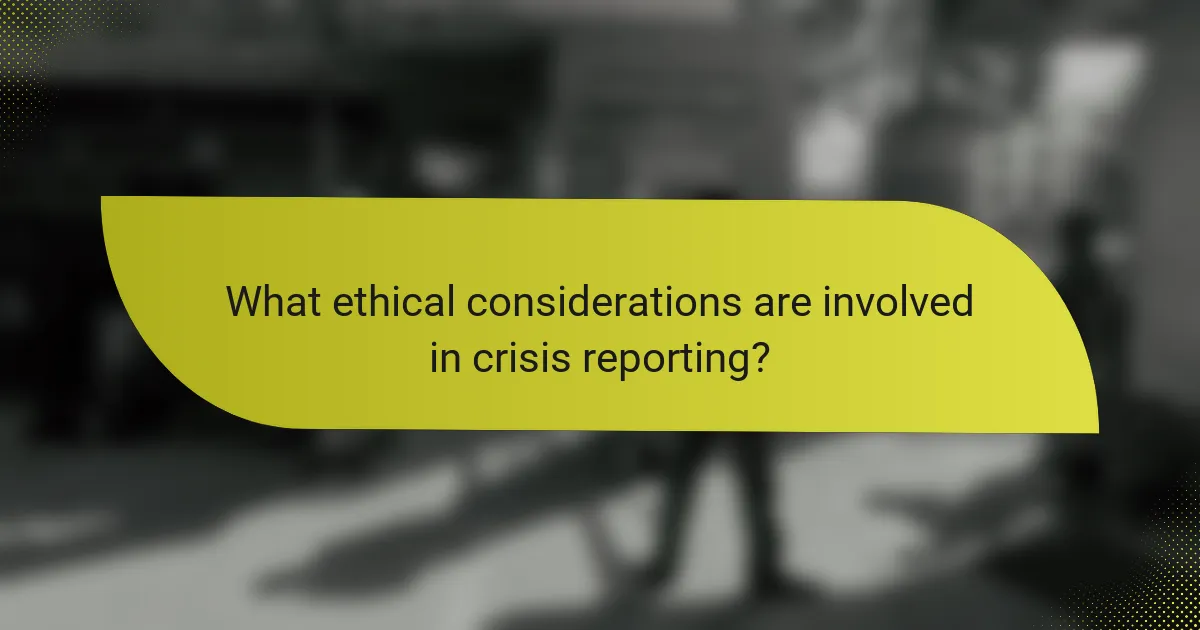
What ethical considerations are involved in crisis reporting?
Crisis reporting involves navigating complex ethical considerations, primarily balancing the need for transparency with the sensitivity required in volatile situations. Journalists must ensure that their coverage does not exacerbate harm while still providing accurate and timely information to the public.
Balancing sensitivity and transparency
In crisis reporting, sensitivity refers to the careful handling of information that could impact vulnerable populations. Transparency, on the other hand, involves openly sharing facts and developments. Journalists must weigh the potential consequences of their reporting, such as causing panic or distress, against the public’s right to know.
For example, when reporting on natural disasters, it is crucial to provide accurate data about the situation without sensationalizing the events. This can be achieved by focusing on verified information and avoiding graphic imagery that may distress audiences.
Guidelines from the International Federation of Journalists
The International Federation of Journalists (IFJ) provides essential guidelines to help journalists navigate ethical dilemmas in crisis situations. These guidelines emphasize the importance of accuracy, fairness, and respect for the dignity of individuals affected by crises.
Key recommendations include verifying information before publication, avoiding speculation, and being mindful of the language used to describe victims and affected communities. Journalists are encouraged to prioritize the safety and well-being of individuals over sensational narratives.
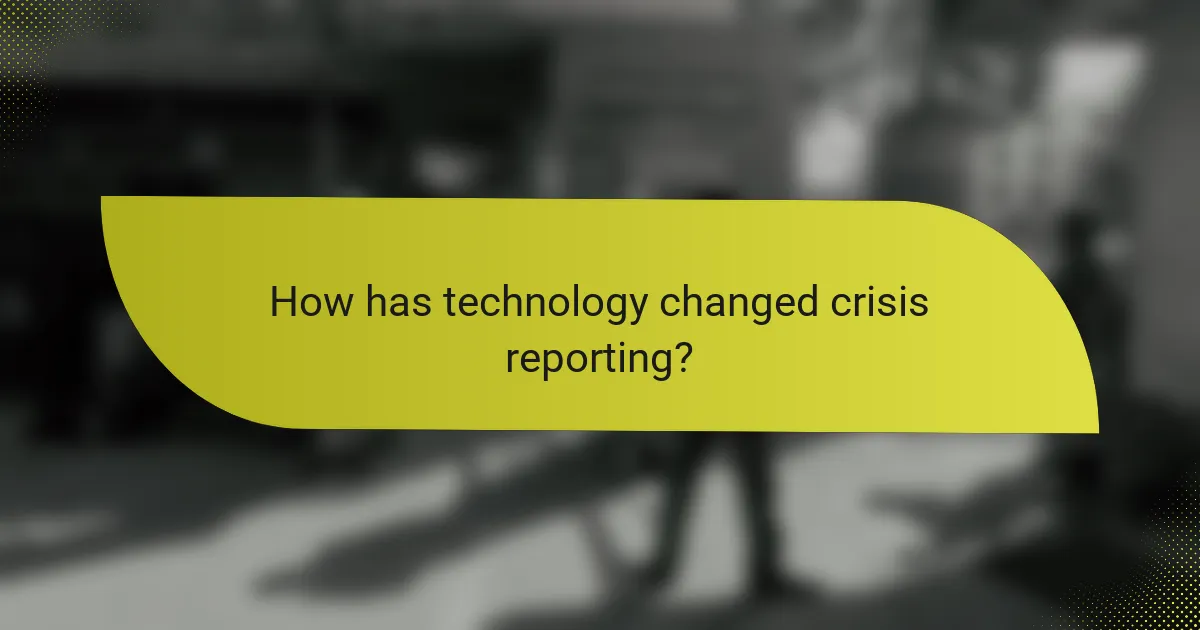
How has technology changed crisis reporting?
Technology has significantly transformed crisis reporting by enhancing the speed, accessibility, and accuracy of information dissemination. Journalists now leverage various digital tools to gather and share news from conflict zones, making real-time updates more feasible than ever.
Emergence of mobile journalism
Mobile journalism, or mojo, has revolutionized how reporters cover crises by enabling them to use smartphones for capturing and broadcasting news. This approach allows journalists to quickly record video, take photos, and write articles on-the-go, often within minutes of an event occurring.
With the proliferation of mobile apps designed for editing and sharing content, reporters can reach audiences through social media platforms, increasing the visibility of critical updates. However, reliance on mobile devices requires journalists to ensure they have reliable internet access and battery life, especially in unstable environments.
Use of drones for coverage
Drones have emerged as a powerful tool in crisis reporting, providing aerial views and real-time footage that ground-based reporters cannot capture. They are particularly useful in assessing damage in disaster zones or monitoring conflict areas without putting journalists at risk.
When using drones, journalists must adhere to local regulations regarding airspace and privacy. In many countries, obtaining permits is essential, and operators should be aware of no-fly zones, especially in sensitive regions. Despite these challenges, drones can significantly enhance the depth and perspective of crisis coverage.
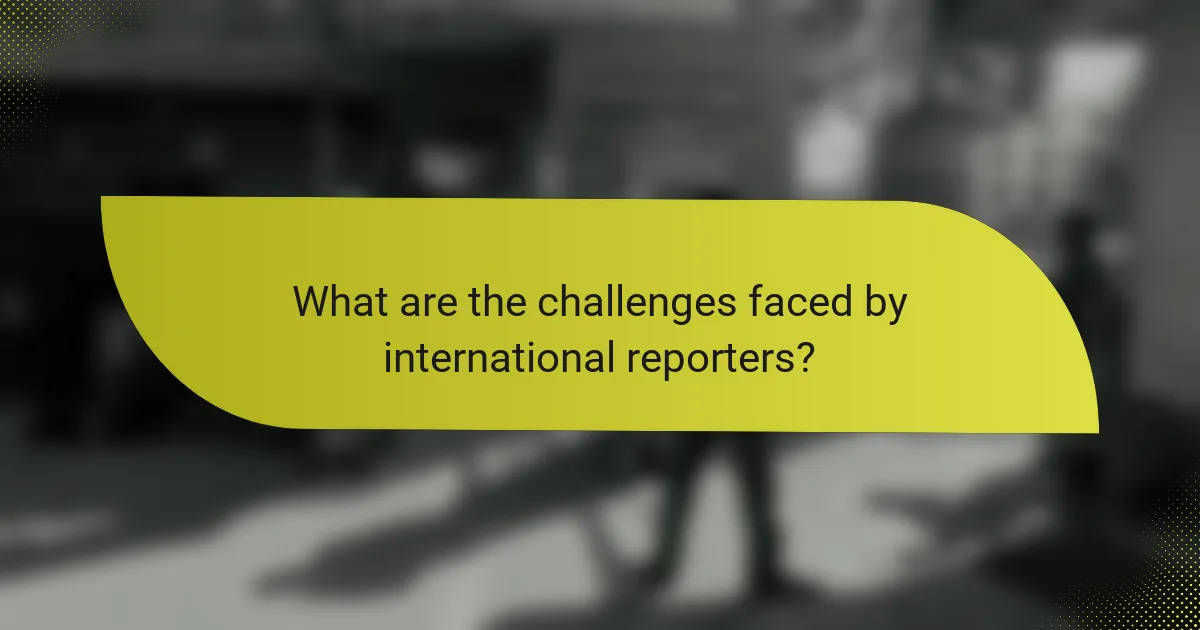
What are the challenges faced by international reporters?
International reporters encounter numerous challenges, including access to conflict zones, safety concerns, and the need for accurate information amidst chaos. These obstacles can significantly impact their ability to report effectively and responsibly.
Access to conflict zones
Access to conflict zones is one of the primary challenges for international reporters. Many regions experiencing conflict have restricted entry due to safety concerns, government regulations, or ongoing military operations. Reporters must often navigate complex logistics, including obtaining permits and ensuring safe transportation.
In some cases, journalists may rely on local contacts or fixers who understand the terrain and can facilitate access. However, this approach carries risks, as local informants may have their own agendas or may be compromised. It’s crucial for reporters to establish trust and verify information through multiple sources.
To improve access, reporters should consider the following tips: always carry proper identification and press credentials, stay updated on local laws and regulations, and maintain a flexible schedule to adapt to changing conditions. Prioritizing safety and thorough preparation can enhance their ability to report from these challenging environments.
